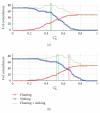Novel diagnostic algorithm for the floating and sunken pulse qualities and its clinical test
- PMID: 21423641
- PMCID: PMC3057659
- DOI: 10.1155/2011/813427
Novel diagnostic algorithm for the floating and sunken pulse qualities and its clinical test
Abstract
We propose a novel classification algorithm for the floating pulse and the sunken pulse using a newly defined coefficient (C(fs)). To examine the validity of the proposed algorithm, we carried out a clinical test in which 12 oriental medical doctors made pairwise diagnoses on the pulses of volunteering subjects. 169 subjects were simultaneously diagnosed by paired doctors, and the diagnoses in 121 subjects were concordant, yielding an accuracy of 72% and a Matthews correlation coefficient of 0.42, which indicates reasonable agreement between doctors. Two sample T-tests showed that subjects in the sunken pulse group had significantly higher BMI and C(fs) (P < .05) than those in the floating pulse group. The pulse classification by the algorithm converged with the diagnoses of paired doctors with an accuracy up to 69%. With these results, we confirm the validity of the novel classification algorithm for the floating and sunken pulses.
Figures









References
-
- Huynh HK, Seifert GM. Pulse Diagnosis by Li Shi Zhen. Sydney, Australia: Paradigm Publications; 1985.
-
- Flaws B. The Secret of Chinese Pulse Diagnosis. Denver, Colo, USA: Blue Poppy Press; 2006.
-
- Walsh S, King E. Pulse Diagnosis: A Clinical Guide. Sydney, Australia: Elsevier; 2008.
-
- Hammer LI. Chinese Pulse Diagnosis: A contemporary approach. Seattle, Wash, USA: Eastland Press; 2001.
-
- Kim JY, Kim KY, Ko KD. A study on the problems and the method for improvement of pulse analyzers. The Journal of the Korea Institute of Oriental Medical Diagnostics. 1999;3(1):28–36.
LinkOut - more resources
Full Text Sources

